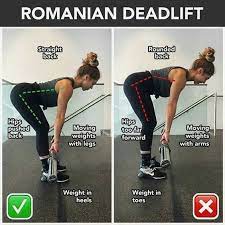The Romanian Deadlift vs Deadlift
Have you ever wondered what the distinction is between the deadlift and the Romanian deadlift? This article outlines the distinctions between the two exercises, which are among the most effective for glute strengthening, and how to perform each one safely and successfully.
The gluteal complex is made up of three muscles: the gluteus maximus, the gluteus medius, and the gluteus minimus. The glutes externally rotate the hips in the transverse plane, extend the hips in the sagittal plane, abduct the hips in the frontal plane, and extend the hips in the sagittal plane. To strengthen the gluteal muscles, perform any exercise that needs the hips to move into one of these motions.
The Romanian deadlift (RDL) and the classic deadlift are two of the most efficient exercises for developing the glutes in the sagittal plane through hip extension motion. While the names of these exercises may be daunting, it’s crucial to remember that they stem from the fact that the weight begins in a static position with no velocity, not from any negative effects that may be encountered while executing the exercise. And, while the titles are similar and both workouts are based on hip hinge action, the RDL and classic deadlift differ in how the motions are performed.
The fundamental distinction between the workouts is that the deadlift begins with the weight lifted from the floor, whereas the RDL begins with the weight held in front of the hips. Other than that, these exercises are similar in that they require the spine to remain stable and non-moving throughout the full range of motion while engaging the glutes and upper legs, making them excellent for building the muscles that move and stabilise the core region.
The deadlift and RDL differ from the squat in that both entail movement largely at the ilio-femoral joints of the hips, with the glutes providing the majority of the force. In contrast, during a squat exercise, the hips and knees move in unison. One of the most important advantages of the deadlift and RDL is that they develop the deep spinal stabilisers. While a weight belt can provide lumbar spine support, it should only be utilised with substantial weights. Use lesser weights when learning the movements to allow the deep core muscles to stabilise the spine (as opposed to the belt). However, while executing maximal loads for three or fewer reps, a belt is recommended for support.
The Barbell Deadlift
One of three lifts utilised in competitive powerlifting is the barbell deadlift (the other two are the bench press and back squat). When properly trained, the deadlift allows humans to lift enormous amounts of weight. However, lifting big weights is not required to reap the benefits of this workout.
Primary Movement Pattern
The hip hinge action pattern is the foundation of the deadlift. In addition to hip joint mobility, correct lift technique necessitates ankle and thoracic spine mobility to allow for proper movement mechanics while preserving spine extension throughout the lift. In addition to the gluteal complex, good deadlifting form includes engaging the hamstrings and adductors, which are hip-extensor muscles, to generate the upward forces required to lift the weight off the floor.
The load in a squat is top-down because it is put on top of the spine, either on the front of the shoulders for a front squat or along the top of the shoulder blades and cervical spine for a back squat. The front or back squat with weight can be an effective exercise for strengthening the muscles that support the spine. However, because the weight is resting on top of the spine, it may cause catastrophic injury if appropriate form is not maintained throughout the range of motion. Because there is no downward, compressive stress on the spine, the deadlift and RDL may be safer than the squat.
Muscle forces are generated in the hip, lumbar spine, ankle, and knee during a typical barbell deadlift; thus, correct deadlift lifting technique necessitates mobility of those joints paired with lumbar spine stability. The barbell should be kept as near to the body as possible throughout the lift for optimal mechanics. Starting with the bar against the shins and keeping it near to the legs throughout the ascent will make it simpler to maintain a straight spine while generating lifting force from the legs.




_updates.jpg)


